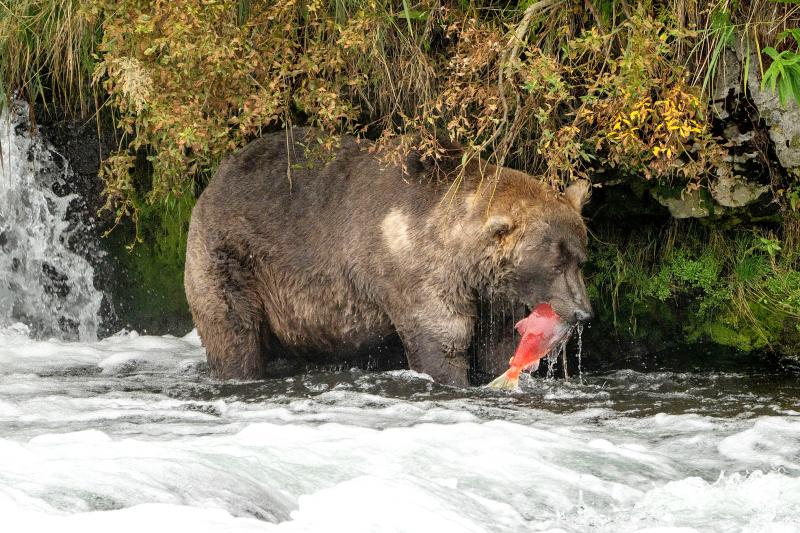One of the ursine elders of Katmai National Park and Preserve in Alaska is now a four-time champion of chunk.
Otis, a brown bear estimated to be 24 to 26 years old, was crowned on Tuesday as the winner of Katmai’s annual Fat Bear Week. He came out on top in an online competition pitting 12 large, salmon-chomping bears against one another.
Otis wound up besting the other finalist, a chocolate-brown male known as Walker, in the final round of voting.

Photo: Reuters
“The portly patriarch of paunch persevered to pulverize the Baron of Beardonkadonk,” the park said in its Twitter announcement.
Fat Bear Week, a joint project of the park and its nonprofit partners, the Katmai Conservancy and the media organization explore.org, has become an Internet sensation.
Wildlife fans submitted votes in a playoff-style competition featuring photographs and video of the bears feasting at a waterfall site on the salmon-rich Brooks River. Explore.org’s “bear cam” captured live footage of the bear action at Brooks Falls.
Otis, thanks to his longevity, is a Fat Bear institution.
First documented at the falls in 2001, Otis was the inaugural Fat Bear champion, winning in 2014 when the event was held on a single day. He also took the 2016 and 2017 titles. The Katmai Conservancy has named a fundraising project after him; last year, the Otis Fund raised more than US$230,000 for Katmai research, education and bear-protection projects.
In his old age, Otis can no longer compete with the younger and stronger bears for prime fishing spots, according to park officials. Two of his canine teeth are missing, and the others are worn.
But when it comes to salmon, Otis is deceptively canny, according to explore.org’s Web site.
“While Otis occasionally appears to be napping or not paying attention, most of the time he’s focused on the water, and he experiences a relatively high salmon catch as a result,” the Web site says.
Katmai sprawls over four million acres on the Alaska Peninsula in the southwestern part of the state. The park is home to about 2,200 brown bears that can grow to 1,000 pounds or more. The bears are fattened by salmon swimming in from Bristol Bay, site of the world’s biggest salmon runs.
The bears need their girth because they can lose a third of their weight during their winter hibernation, park officials said.
Even with Fat Bear Week over, park officials said on Twitter that Otis “is still chowing down.”

Taiwan Power Co (Taipower, 台電) and the New Taipei City Government in May last year agreed to allow the activation of a spent fuel storage facility for the Jinshan Nuclear Power Plant in Shihmen District (石門). The deal ended eleven years of legal wrangling. According to the Taipower announcement, the city government engaged in repeated delays, failing to approve water and soil conservation plans. Taipower said at the time that plans for another dry storage facility for the Guosheng Nuclear Power Plant in New Taipei City’s Wanli District (萬里) remained stuck in legal limbo. Later that year an agreement was reached

What does the Taiwan People’s Party (TPP) in the Huang Kuo-chang (黃國昌) era stand for? What sets it apart from their allies, the Chinese Nationalist Party (KMT)? With some shifts in tone and emphasis, the KMT’s stances have not changed significantly since the late 2000s and the era of former president Ma Ying-jeou (馬英九). The Democratic Progressive Party’s (DPP) current platform formed in the mid-2010s under the guidance of Tsai Ing-wen (蔡英文), and current President William Lai (賴清德) campaigned on continuity. Though their ideological stances may be a bit stale, they have the advantage of being broadly understood by the voters.

In a high-rise office building in Taipei’s government district, the primary agency for maintaining links to Thailand’s 108 Yunnan villages — which are home to a population of around 200,000 descendants of the Chinese Nationalist Party (KMT) armies stranded in Thailand following the Chinese Civil War — is the Overseas Community Affairs Council (OCAC). Established in China in 1926, the OCAC was born of a mandate to support Chinese education, culture and economic development in far flung Chinese diaspora communities, which, especially in southeast Asia, had underwritten the military insurgencies against the Qing Dynasty that led to the founding of

Artifacts found at archeological sites in France and Spain along the Bay of Biscay shoreline show that humans have been crafting tools from whale bones since more than 20,000 years ago, illustrating anew the resourcefulness of prehistoric people. The tools, primarily hunting implements such as projectile points, were fashioned from the bones of at least five species of large whales, the researchers said. Bones from sperm whales were the most abundant, followed by fin whales, gray whales, right or bowhead whales — two species indistinguishable with the analytical method used in the study — and blue whales. With seafaring capabilities by humans